15 minutes later I emerged from the subway into a barrage of stinging hail. Slowly, I purposely walked and slipped my way in a westward direction towards the MET. Traffic was minimal, a rare sight in New York. Since it lay on the verge of Central Park, I thought I'd make a short detour into the park. Old dears gingerly plodded the crisp and even footpaths, their small dogs wearing designer dog-coats trotting along behind them. All manner of joggers bounded by, some wearing nothing but lycra. The more hilly areas of the park were bedecked with families; kids sledging down the hills and dads pulling them back up. It was magical.
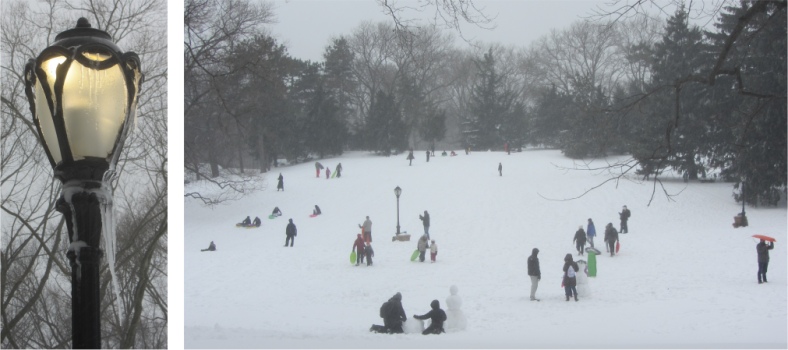
Sledging in the Snow and Hail
|
I returned back to the entrance of the MET. A "cursing" of people stood outside. Bloody fools, I thought, why don't they just go inside. Then a security guard popped his head out of a door to advise a chap that they were closed. "What!" I gasped. An elderly couple nearby smiled and confirmed what I had just heard. I opened the door to the building and asked if the Guggenheim up the road was open. "No, it is shut too," replied the smug fellow in his warm retreat.
"Ah, how about the National History Museum across the park?"
"That is also shut."
"What's going on?" I enquired after hearing this incredulous answer.
"It's because of the mayor. He decided that the weather is so inclement that he has decided to close down the city. So we are closed down. But the Museum of Modern Art on 53rd Street is open," and with that he closed the door firmly on me. I related the story to the elderly couple, who smiled weakly. "It is a hell of a walk," the chap sighed to me.
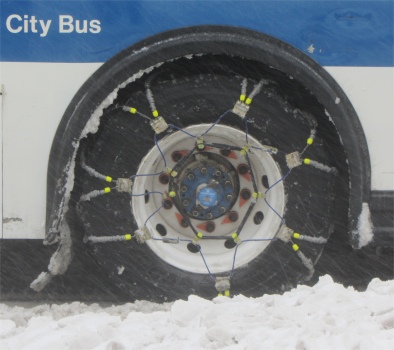
Snow Chains are the Order of the Day
|
I departed, and walked all the way down to the bottom of the Central Park. Even the zoo in the park was closed. Another few blocks brought me to 53rd Street. By now, some cabs were requiring a push, and many were being dug out. Oh what fun. Armies of men did their utmost to shovel snow and ice off the pavements, and some were using what looked like rotovators which just fired snow onto the roads or abandoned cars. The pavements seemed more slippery after being "cleared" of snow than those still covered. On some stretches folk were employed to scatter salt on the pavements.
On entering the Museum of Modern Art (MoMA), I discovered everybody else had sought refuge there too. The place was absolutely heaving with folk, most wearing inflated Michelin Men type attire. A massive queue snaked around the city's equivalent of Hampton Court Maze, but it was fast moving.
The idea for The Museum of Modern Art was developed in 1929 primarily by Abby Aldrich Rockefeller, wife of John D. Rockefeller, Jr., and two of her friends, Lillie P. Bliss and Mary Quinn Sullivan. They became known variously as "the Ladies", "the daring ladies" and "the adamantine ladies". They rented modest quarters for the new museum in the Heckscher Building at 730 Fifth Avenue in Manhattan, and it opened to the public on 7th November 1929, nine days after the Wall Street Crash. At the time, it was America's premier museum devoted exclusively to modern art, and the first of its kind in Manhattan to exhibit European modernism.

"Transparence - Tete et Cheval" : Francis Picabia - (c. 1930)
|
MoMA has been important in developing and collecting modernist art, and is often identified as one of the largest and most influential museums of modern art in the world. MoMA's collection offers an overview of modern and contemporary art, including works of architecture and design, drawing, painting, sculpture, photography, prints, illustrated books and artist's books, film, and electronic media.
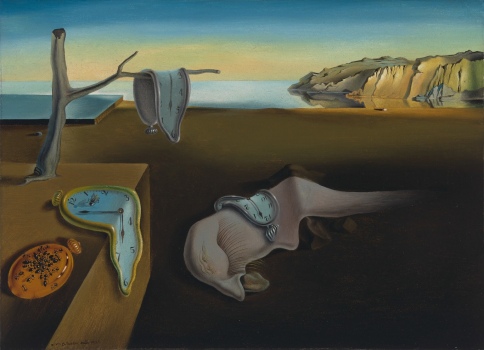
"The Persistence of Memory" : Salvador Dali - 1931
|
Considered by many to have the best collection of modern Western masterpieces in the world, MoMA's holdings include more than 150,000 individual pieces in addition to approximately 22,000 films and 4 million film stills.
The first exhibition to hit me on the ground floor was
Francis Picabia: Our Heads Are Round so Our Thoughts Can Change Direction, a comprehensive survey of Picabia's audacious, irreverent, and profoundly influential work across mediums. This was the first exhibition in the United States to chart his entire career.
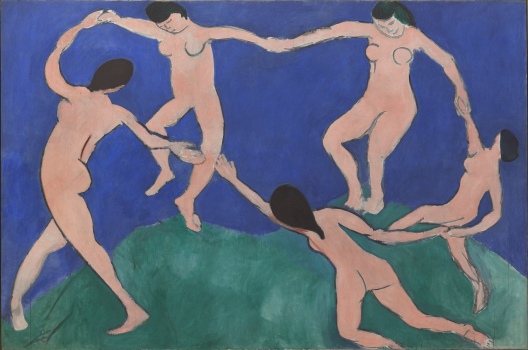
"Dance (1)" : Henri Matisse
|
Among the great modern artists of the past century, Francis Picabia (French, 1879-1953) also remains one of the most elusive. He vigorously avoided any singular style, and his work encompassed painting, poetry, publishing, performance and film. Though he is best known as one of the leaders of the Dada movement, his career ranged widely, and wildly, from Impressionism to radical abstraction, from Dadaist provocation to pseudo-classicism, and from photo-based realism to art informal. Picabia's consistent inconsistencies, his appropriative strategies, and his stylistic eclecticism, along with his sceptical attitude, make him especially relevant for contemporary artists, and his career as a whole challenges familiar narratives of the avant-garde.
The exhibition featured over 200 works, including some 125 paintings, key works on paper, periodicals and printed matter, illustrated letters, and one film. The exhibition aimed to advance the understanding of Picabia's relentless shape-shifting, and how his persistent questioning of the meaning and purpose of art ensured his iconoclastic legacy's lasting influence. To be frank I had never come across Picabia before, but I really enjoyed his work and his attitude to the system.
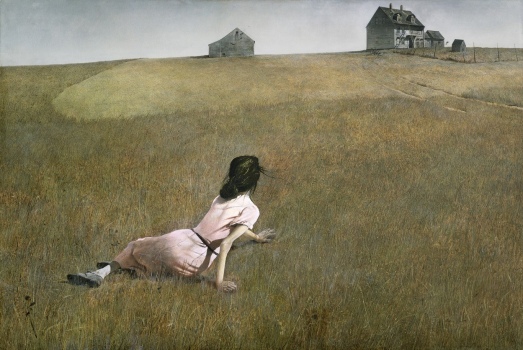
"Christina's World" : Andrew Wyeth - 1948
|
I also spent some time in the
Collection Galleries 1880 - 1950. Within an overall chronological flow, the galleries highlighted individual stylistic movements, artists, and themes, including Cubism, the work of Henri Matisse, and Claude Monet's Water Lilies, among other subjects. These galleries are frequently reinstalled in an effort to feature a wide range of artworks in various configurations, reflecting the view that there are countless ways to explore the history of modern art and the Museum's rich collection.
Moving on to another exhibition, comprising almost 700 snapshot-like portraits sequenced against an evocative music soundtrack, Nan Goldin's
The Ballad of Sexual Dependency was a deeply personal narrative, formed out of the artist's own experiences around Boston, New York, Berlin, and elsewhere in the late 1970s, 1980s, and beyond. Titled after a song in Bertolt Brecht and Kurt Weill's
The Threepenny Opera, Goldin's Ballad was itself a kind of downtown opera; its protagonists, including the artist herself, were captured in intimate moments of love and loss. They experienced ecstasy and pain through sex and drug use; they revelled at dance clubs and bonded with their children at home; and they suffered from domestic violence and the ravages of AIDS. "The Ballad of Sexual Dependency is the diary I let people read," Goldin wrote. "The diary is my form of control over my life. It allows me to obsessively record every detail. It enables me to remember." The Ballad developed through multiple improvised live performances, for which Goldin ran through the slides by hand and friends helped prepare the soundtrack-from Maria Callas to
The Velvet Underground, for an audience not unlike the subjects of the pictures. The Ballad was presented in its original 35mm format, along with photographs that also appeared as images in the slide show. Introducing the installation was a selection of materials from the artist's archive, including posters and flyers announcing early iterations of The Ballad.
Also on show were other exhibitions such as Tony Oursler's
Imponderable, but Teiji's
Lovers and the exhibition on design,
How Should We Live? Propositions for the Modern Interior, left me dry. Despite that, I found the breadth of material in the museum was extensive and refreshing, the fact that I was there till closing time bore testament to my enjoyment. I was glad I had visited.
I picked up Broadway and started slip-sliding my way downtown. As expected, traffic was still minimal, but now hundreds of people were trudging the streets. Perhaps they had all just left the MoMA too. The bright lights on the famous street, coupled with the deep snow, and the falling snow which had replaced the hail, gave it an ethereal atmosphere.
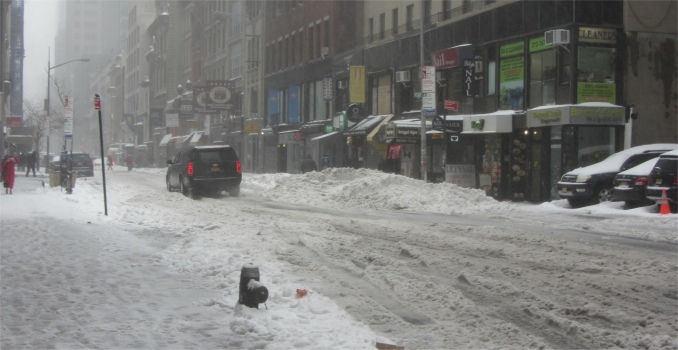
Side Street off Broadway
|
The peace was shattered by a sudden wailing of sirens and horns, all seeming to converge in my direction. Two fire engines shot by, beaming out enough lumens from their flashing lights to compete with Broadway itself. They spun and slid to the left a couple of blocks further along. Then another engine poked its nose out from a side street just behind me. The noise it was pouring out would have competed with a jet engine, in fact it was painful. Its driver was not taking any prisoners, he made it clear he wanted the cars in front of him to jump the traffic lights so that he could gain access to the main road. He soon followed his two other colleagues up the other street.
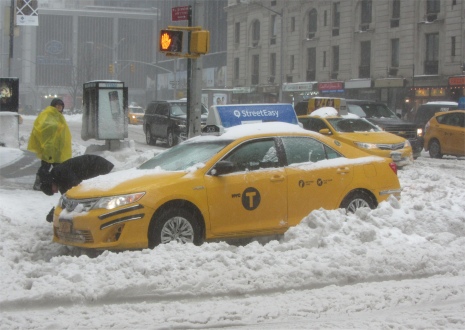
Digging Out His Cab
|
I hatched a plan to head down to Little Italy and Chinatown, and to find some food there. Rather than use the subway, I opted to walk; I had not done any serious exercise other than swimming for ages. I stopped off for a coffee on my hike. On the table opposite, facing me, was a burly policeman. He seemed to be eyeing everyone suspiciously, but he seemed to be running his eyes over me the most. Did I resemble a terrorist disguised as a Michelin Man? I let him get on with formulating his enigmatic theories. After a while he arose, glared at me, and walked past. My eyes did not follow him. When I left, I noticed he was still sitting in the same cafe, sitting on a window seat, stuffing himself with calories. I presumed crime levels must drop dramatically in such inclement weather.
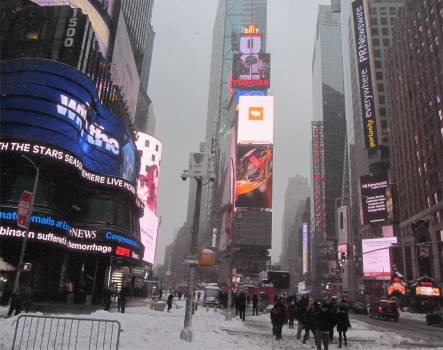
Times Square in the Snow
|
The walk would have taken an hour in normal conditions, today it took over twice as long. I had not eaten since breakfast so I had a raging appetite. Most restaurants had followed the mayor's dictate and had closed, but I did find a little gem that offered Shanghai cuisine. It was warm, well-lit and inviting. Many young people were gathered in groups around circular tables scoffing veritable feasts.
I ordered, and whilst waiting for my food, my eyes fixed upon a poster on the wall just above me. Its content dealt with how to recognise if someone is choking, what actions to take if that person is standing, sitting or unconscious, and how to perform the Heimlich Manoeuvre. Crumbs, I thought, does the food in this establishment choke many people. The food was delicious, and nobody choked.
I took the subway to the World Trade Centre, and caught a PATH train back to Journal Square. By now it had stopped snowing, and the deep freeze was turning any slippery slush into ice. I took a precautionary trip to a bar in the square. Here, small groups of men were engaged in animated conversations at the long bar, some in languages I did not understand. Three large TV screens relayed a mix of pop-videos and the baseball equivalent of
Match of the Day. The solitary woman behind the bar, who seemed to be a Latino in her early 30s, had everything under control. The short break had invigorated me sufficiently for the last few hundred metres slide back to my hotel.











